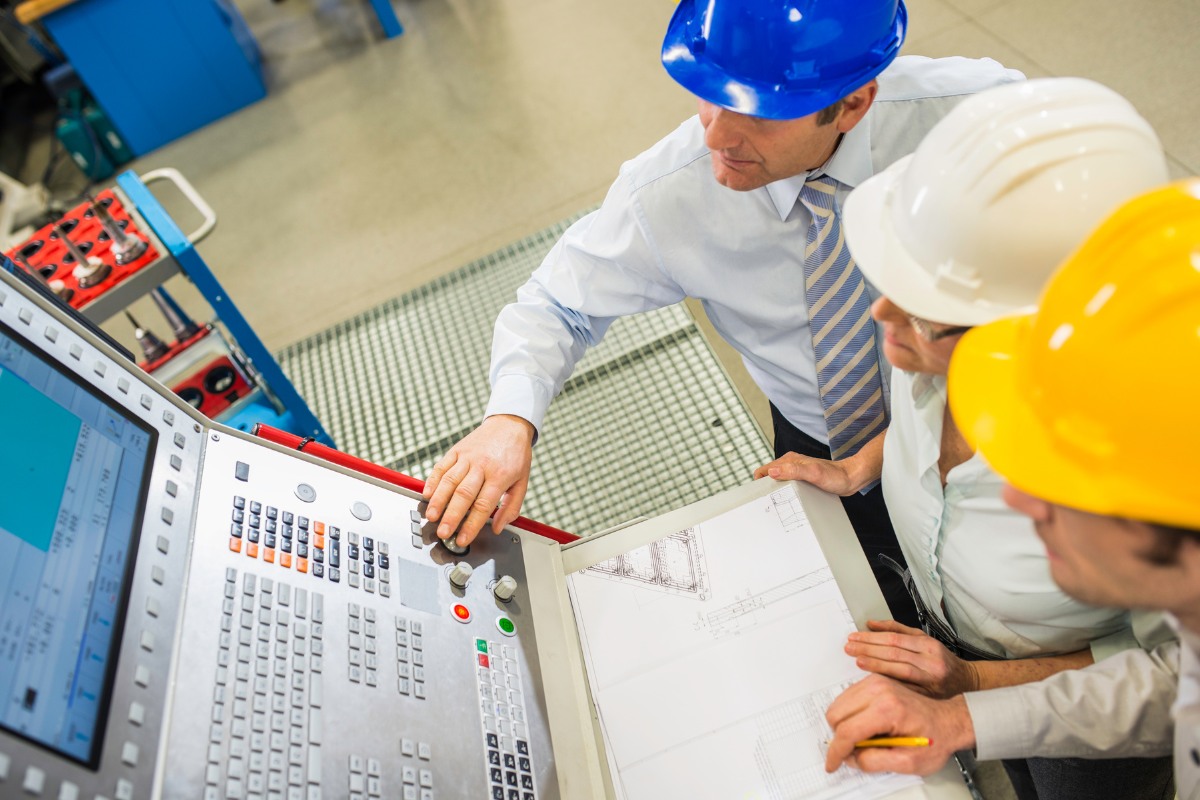고객으로부터 CAM 데이터와 작업별 정보를 받아 CAM실 담당자가 완성도를 꼼꼼히 확인합니다. 제조 공정 전반에 걸쳐 사용될 패널을 활용하기 위해 보드 패턴을 복사하고 배열합니다. 그런 다음 툴링 홀, 테스트 쿠폰 및 신원 정보를 레이아웃에 추가합니다. 이 데이터는 레이저 포토플로터, CNC 드릴링 및 라우팅 머신, AOI, 전기 테스터 등의 장비에서 제조 공정 전반에 걸쳐 사용되는 형식으로 변환됩니다. 고객이 제공하는 데이터 패키지의 품질에 따라 CAM 부서의 업무가 크게 향상됩니다. 고객 데이터의 일반적인 단점으로는 치수가 잘못되었거나 도면이 없는 경우, 판독 가능한 텍스트 파일이 없는 경우, 메모나 사양이 부실하거나 존재하지 않는 경우, 설계 표준(즉, 비 IPC)을 사용하여 생성되지 않은 설계 등이 있습니다.
필름 룸
통제된 환경 조건에서 전자동 레이저 포토플로터와 필름 처리 장비를 사용하여 마스터 필름 툴 세트를 플로팅합니다. 그런 다음 마스터 필름 툴을 검사하고 이미징, 스크리닝 및 검사 담당자가 사용할 수 있도록 디아조 필름에 복사합니다.
내부 레이어 처리
이미징 담당자는 감광성 에칭 레지스트 필름으로 구리 피복 코어(내층) 재료를 라미네이팅하는 것으로 시작합니다. 적층된 코어에 은막 도구를 등록하고 자외선 광원에 노출시킵니다. 그런 다음 내층을 현상하여 결국 구리가 없어질 영역의 구리에서 레지스트 필름을 제거합니다. 그런 다음 노출된 구리는 구리를 녹이는 에칭 용액을 사용하여 제거합니다. 마지막으로 에칭 레지스트 필름이 제거되어 완성된 내부 레이어 패널이 드러납니다.
다층 라미네이션
라미네이션 영역에서 완성된 내부 레이어 패널은 내부 레이어에 짙은 갈색/검은색 표면을 생성하는 공정으로 처리됩니다. 이렇게 수정된 표면은 다층 보드의 접착력을 높입니다. 준비된 내부 레이어를 프리프레그라고 하는 부분 경화 에폭시 시트 재료와 번갈아 가며 쌓아 다층 패널을 만듭니다. 그런 다음 패널을 유압 프레스에 넣고 극한의 압력으로 누른 후 정해진 시간 동안 가열합니다. 프리프레그 재료가 녹아 층간 도체 사이의 공간으로 강제 주입됩니다. 용융된 에폭시가 정확한 온도에 도달하면 굳어지고, 이때 에폭시는 경화가 완료됩니다. 사이클이 끝나면 패널이 냉각되고 프레스에서 제거되어 이제 드릴링 작업을 할 준비가 됩니다.
드릴링
공급업체의 기본 자재 또는 프레스 다층 패널을 멀티 스핀들 CNC 드릴링 장비에 쌓아 올립니다. 솔리드 카바이드 드릴 비트가 매거진에 로드되어 드릴링 머신에 배치됩니다. CAM 룸에서 생성된 프로그램이 컨트롤러에 로드되고 프로그램이 실행됩니다. 드릴링 작업은 여기서부터 완전 자동으로 이루어집니다. 기계는 드릴 비트를 고속 에어 베어링 스핀들에 로드하고 속도와 이송 속도를 설정하며 드릴 직경, 길이 및 런아웃을 확인합니다.
홀 활성화
홀 활성화는 일련의 화학 용액을 사용하여 구리로 홀 벽을 세척, 준비 및 활성화하여 전기 전도성 홀을 생성하는 프로세스입니다. 이렇게 하면 구리가 에폭시 코어 재료에 전기 도금되어 도금된 스루홀이 생성됩니다. 이것이 내부와 외부 레이어의 전기적 상호 연결의 시작입니다.
이미징
감광성 레지스트 필름이 드릴링된 패널에 라미네이트됩니다. 다이아조 필름 도구를 라미네이트된 패널에 등록한 다음 자외선에 노출시킵니다. 포토레지스트가 현상되어 결국 도체로 남게 될 영역의 구리가 드러납니다.
도금 / 에칭
그런 다음 이미지화된 패널을 화학적으로 세척하고 전기 도금 탱크에 넣습니다. 구리가 홀 벽과 노출된 도체 영역에 전기 도금됩니다. 포토레지스트 필름으로 가려진 영역에는 금속이 도금되지 않습니다. 패널은 얇은 주석 도금 층을 위해 주석 전기 도금 탱크로 옮겨집니다. 이 주석 층은 에칭 공정에서 새로 도금된 구리를 보호하는 데 사용됩니다. 레지스트 필름이 제거되어 에칭할 구리 영역이 드러납니다. 불필요한 구리는 에칭 용액을 사용하여 용해시키고 주석 도금으로 보호되는 부분만 남깁니다. 그런 다음 주석을 제거하여 구리 도체와 접지 영역을 드러냅니다.
마스킹
도금 및 에칭된 패널은 솔더 마스크 코팅을 적용하기 전에 세척 및 검사를 거칩니다. 그런 다음 솔더 마스크 코팅을 컨베이어 스프레이 기계로 도포한 후 IR 택 드라이로 건조합니다. 사용되는 솔더 마스크는 LPI(액상 사진 이미징 가능)라고 하며 빛에 민감합니다. 점착 건조 후 디아조 필름 툴을 코팅 패널에 등록하고 패널을 자외선 광원에 노출시킵니다. 그런 다음 솔더 마스크 코팅 패널을 현상하면 마스크가 제거되고 패드 또는 필름 툴로 보호된 영역이 노출됩니다. 마지막으로 패널을 구워 솔더 마스크 잉크의 경화를 마무리합니다.
표면 마감
그런 다음 패널을 여러 가지 공정을 거쳐 다양한 표면 마감 처리를 할 수 있습니다. 그 중 가장 일반적인 공정은 열풍 솔더 레벨링(HASL) 공정입니다. 이 공정에서는 패널을 화학적으로 세척하고 플럭스를 도포합니다.
기타 표면 마감으로는 니켈(Ni) 위에 전기 도금된 금(Au), 무전해 니켈 침지 금(ENIG), 흰색 주석, 무연 솔더 마감 등이 있습니다. RoHS 지침을 충족하는 무연 마감의 경우 ENIG, 흰색 주석 및 무연 솔더가 제공됩니다.
표시 / 범례
Vista Technology에서 적용되는 모든 실크스크린 마킹과 범례는 LPI(액체 사진 이미징 가능) 잉크를 사용하여 이루어집니다. 따라서 아주 작은 피처(0.006인치 미만)뿐만 아니라 눈에 잘 띄는 회로 위에 배치되는 피처에 대해서도 매우 선명한 이미지를 보장합니다.
라우팅
완성된 패널은 CNC 라우터를 사용하여 프로파일링하거나 절단합니다. 라우터는 개별 보드의 치수 프로파일을 생성하도록 프로그래밍되어 있습니다. 기계는 카바이드 절단 비트를 사용하여 보드의 프로파일을 라우팅합니다. 완성된 보드의 치수를 확인하여 인쇄합니다. 그런 다음 보드를 세척하여 테스트 및 검사 구역으로 보냅니다.
테스트 및 최종 검사
고객의 데이터는 테스트 장비에 필요한 형식으로 변환됩니다. 생성된 테스트 데이터는 고객이 제공한 설계에 따라 완성된 보드를 테스트합니다. 개별 기판이 테스터에 로드되고 기계가 일련의 전기 테스트를 실행합니다. 절연 및 저항에 대한 전기 테스트를 통과한 기판은 표시가 되어 최종 검사 부서로 보내집니다.
품질 관리
품질 관리는 전체 CAM 프로세스의 필수적인 부분입니다. 최종 제품이 최고의 기준을 충족하는지 확인하기 위해 각 생산 단계를 꼼꼼하게 모니터링합니다. 여기에는 정기적인 검사, 테스트, 검증을 통해 불일치를 조기에 발견하는 것이 포함됩니다. 엄격한 품질 관리 조치를 유지함으로써 최종 제품이 신뢰할 수 있고 고객 사양을 충족할 수 있도록 보장합니다.
환경적 고려 사항
오늘날의 제조 환경에서는 환경을 고려하는 것이 그 어느 때보다 중요해졌습니다. 소니의 CAM 프로세스는 폐기물을 최소화하고 환경에 미치는 영향을 줄이도록 설계되었습니다. 여기에는 친환경 소재 사용, 폐기물 재활용, 모든 화학 공정이 환경 규정을 준수하도록 보장하는 것이 포함됩니다. 지속 가능성을 우선시함으로써 규제 요건을 충족할 뿐만 아니라 더 건강한 지구를 만드는 데 기여하고 있습니다.
